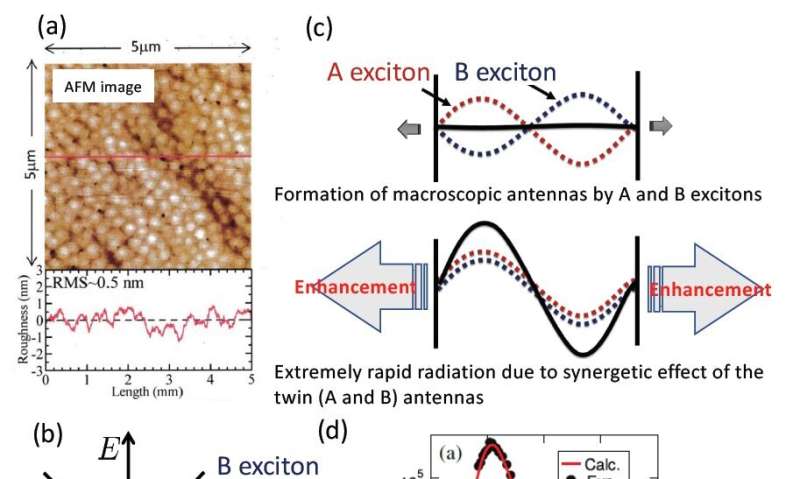Excitonic radiative decay faster than thermal dephasing in ZnO thin films

A team of researchers from Osaka University, Osaka Prefecture University, Osaka City University, and The University of Shiga Prefecture have found excitonic radiative decay faster than thermal dephasing at room temperature in zinc oxide (ZnO) thin films. These results, published recently in Physical Review Letters, will greatly reduce the thermal energy loss in optical operations.
An exciton is a bound state of an electron and an electron hole which are attracted to each other. ZnO, which has a wide band gap and high excitonic stability, is studied as a promising material for various photonic devices such as blue/ultraviolet-emitting diodes, ultraviolet lasers, and ultraviolet absorption solar batteries.
Atoms and molecules can absorb the light energy and jump to a higher energy level (excited state), but in the reverse process, known as light emission, they return to the ground state by releasing the extra energy they absorbed. This is called an "optical process." To enhance emission efficiency in solid devices such as light-emitting diodes, it is necessary to strengthen light-matter interaction and speed up absorption and emission of light; however, the marginal performance of ZnO consisting of double exciton bands (Figure 1b) was not well understood.
Speeding up the optical process is important in realizing energy-saving, high-efficiency optical devices because an optical process faster than thermal dephasing would reduce thermal energy loss; however, there were no clear guiding principles to develop high-speed photonic devices and it was thought that the radiative decay of excited states in solids took at least several tens of picoseconds (ps).
The constituent atoms and molecules in solids play the role of dipole antennas whose excited energies are emitted as light. The size of spatial expansion of these antennas determines speed and efficiency of light radiation, or the performance of light-emitting devices.
In this study, the team proposed a new theory: a macroscopic number of atoms cooperatively form widely extended giant antennas in ZnO crystals and the "twin antennas" synchronously oscillate reinforcing with each other due to the valence band degeneracy of ZnO. (Figure 1c)
In experiments, they measured radiative decay times by using high quality ZnO thin films (Figure 1a), demonstrating that extremely fast decay of just under 20 femtoseconds (fs) took place. (Figure 1d) This speed is three orders of magnitude faster than ever observed in typical semiconductors and even faster than the speed of thermal dephasing of excitons at room temperature, which will open the avenue to realizing "ultra-fast and thermal-free" photonics.
Lead author Matsuda says, "In principle, heat is not produced in an optical process faster than thermal dephasing of excitons, so it can be said that our research results will serve as a guiding principle to develop next-generation photonic devices with non-thermogenic, next-generation ultra-low energy consumption. Conventional optical devices generate heat and active optical devices absorbing light, in particular, increase power consumption. Our new theory will help realize a sustainable society beyond energy efficiency limits conventionally taken for granted."
More information: Takashi Kinoshita et al, Synergetic Enhancement of Light-Matter Interaction by Nonlocality and Band Degeneracy in ZnO Thin Films, Physical Review Letters (2019). DOI: 10.1103/PhysRevLett.122.157401
Journal information: Physical Review Letters
Provided by Osaka University




















